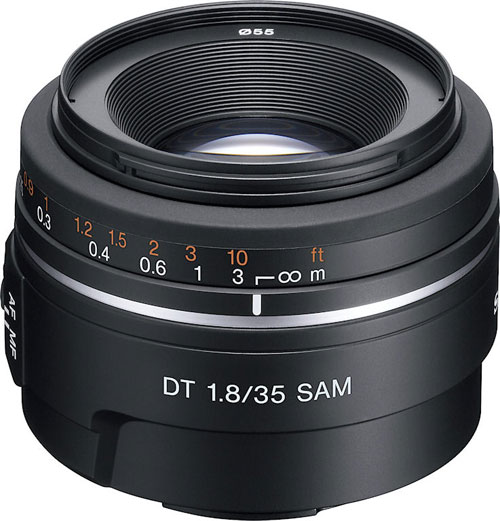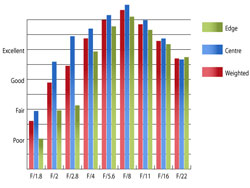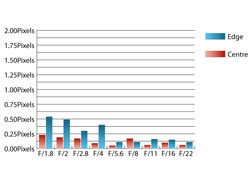Sony DT 50mm f/1.8 SAM
 |
| Gary Wolstenholme investigates this budget 50mm lens for Sony's range of crop sensor digital SLRs. |
Sony's DT 50mm f/1.8 SAM lens boasts a smooth autofocus motor (SAM), bright f/1.8 maximum aperture and lightweight construction all for around £145. It is designed for Sony's range of APS-C DSLRs and so cannot be used on a full frame camera. The SAM focusing system is compatible with Sony's cameras that rely on the lens having a motor built in to focus, such as their NEX range of cameras.
Those looking for a slightly brighter maximum aperture may consider Sony's 50mm f/1.8 lens, which can be picked up for around £320. This lens focuses via the built in screw drive in their SLR cameras, so owners of Sony's NEX cameras will have to muddle through with manual focus if they wish to use this lens.
Sigma's 50mm f/1.4 EX DG HSM is another alternative. This lens costs around £370 and includes a bright maximum aperture of f/1.4 and a fast silent focusing motor that allows manual focus adjustments to be made at any time.
Sony DT 50mm f/1.8 SAM: Handling and features
In terms of build quality and features, this 50mm lens from Sony is pretty basic. The lens barrel and mount are both constructed from lightweight, rigid plastics, which keep the cost and the weight down.
Sony's SAM focusing system isn't a silent motor, as found on their SSM lenses, but more a quick lens based focusing motor that will allow the lens to be used on Sony's cameras that do not support screw-driven focus, such as their NEX range. The focusing motor isn't particularly quiet, but it is quick, zipping from one end of the focus range to the other in a matter of about a second. Focusing is accurate much of the time, but occasionally the lens did hunt around before locking on when using an A450 body. As this lens will often be used for portraiture a circular aperture design has been used on this lens to improve the appearance of the out of focus background blur.
A switch is provided on the side of the lens barrel for changing between manual and automatic focusing. The position of this control is communicated to the camera, meaning that this control is the only one you'll need to alter when switching to manual focus from automatic.
Sony DT 50mm f/1.8 SAM: Performance
Standard lenses like this have become popular for the excellent quality they can produce for a relatively low price. This lens does not fail to disappoint, although it will need stopping down quite a bit to see what the lens is truly capable of.
At f/1.8 the sharpness in the centre is fair, but may be a bit soft for many people's taste and the quality towards the edges is poor. This isn't necessarily a disaster though, as for portraiture this could produce pleasant results. The resolution in the centre of the frame improves dramatically the more it is stopped down, as far as f/2.8 and the quality towards the edges starts to catch up by around f/4. Peak resolution across the frame is achieved at f/8, where the qualty across the frame is truly superb.
With simple lens designs like this, chromatic aberrations are rarely an issue. What fringing there is is at its worst at maximum aperture and gradually decreases to negligible levels as the aperture is stopped down. Still, the level of colour fringing present should only be visible in very large prints.
Falloff of illumination towards the corners is around the level I would normally expect for a simple wide aperture lens like this. At f/1.8 the corners are 2.11 stops darker than the image centre and the lens needs to be stopped down to f/4 to achieve visually uniform illumination.
A slight amount of barrel distortion is present which is quite surprising for a prime lens. Imatest detected 1.21% barrel distortion, which will still be very difficult to spot, but may cause issues in very critical applications, such as copystand work. Luckily the distortion pattern is uniform across the frame, so it should be easy enough to correct in image editing software afterwards.
| Click on the thumbnails for a high resolution image. |
 |
| Superb resolution across the frame is possible when stopped down the apertures of around f/8. |
Flare and loss of contrast can be an issue when shooting into the light at wide apertures, but thanks to the simple optical design, this occurs rarely. No hood or shade is supplied with the lens, but the front element is recessed a little, giving it a little bit of protection from extraneous light. Strong light sources from outside of the picture area may also cause a little flare and/or loos of contrast, so care may need to be taken under these conditions.
 | DxOMark provides objective, independent, RAW-based image quality performance data for lenses and digital cameras to help you select the best equipment to meet your photographic needs. Visit the DxOMark website for tests performed on the Sony DT 50mm f/1.8 SAM. |
Sony DT 50mm f/1.8 SAM: Verdict
Although this lens is not the best performer when it comes to resolution at maximum aperture, it should still make a great portrait lens when stopped down a little for those on a budget. The out of focus blur is quite smooth and pleasant too.
Stopping the lens down to moderate aperture yields images with superb resolution across the frame, which isn't bad for a lens that only costs around £145.
Sony DT 50mm f/1.8 SAM: Pros
 Lightweight
Lightweight Quality when stopped down
Quality when stopped down Cheap
CheapSony DT 50mm f/1.8 SAM: Cons
 Basic design may be off-putting to some
Basic design may be off-putting to some Softness at maximum aperture
Softness at maximum aperture AF hunts occasionally
AF hunts occasionally| FEATURES |  |
| HANDLING |  |
| PERFORMANCE |  |
| VALUE FOR MONEY |  |
| OVERALL |  |
Sony DT 50mm f/1.8 SAM: Specification
| Price | £145.00 |
| Contact | www.sony.co.uk |
| Filter size | 49mm |
| Format | APS-C |
| Construction | 6 elements in 5 groups |
| Angle-of-view | 32 degrees |
| 35mm equivalent focal length (on APS-C body) | 75mm |
| Internal focusing | No |
| Image stabilisation | No |
| Minimum focus | 34cm |
| Maximum aperture | f/1.8 |
| Minimum aperture | f/22 |
| Weight | 170g |
| Size | 70 x 45mm |
| In the box | Lens caps |
The Sony DT 50mm f/1.8 SAM costs around £145 and is available from Warehouse Express here:
Sony DT 50mm f/1.8 SAM
Add your message
Login required
Please login here or if you've not registered, you can register here. Registering is safe, quick and free.
Please login here or if you've not registered, you can register here. Registering is safe, quick and free.
photodo Stats
1102 lenses
428 MTF tests
74 in-depth photodo reviews
100+ users join each day
Help the lens community by reviewing or rating a lens today via our lens search
428 MTF tests
74 in-depth photodo reviews
100+ users join each day
Help the lens community by reviewing or rating a lens today via our lens search
Latest Lens Reviews
- Chinon 28mm f/2.8 Vintage Lens Review
- Canon EF 70-200mm f/4L IS II USM Lens Review
- Samyang AF 85mm f/1.4 EF Review
- Sigma 70mm f/2.8 DG Macro Art Review
- Samyang AF 24mm f/2.8 FE Review
- Meike 50mm f/1.7 Review
- Tamron 70-210mm f/4 Di VC USD Review
- Lensbaby Burnside 35mm f/2.8 Review
- Asahi Super Takumar 50mm f/1.4 Review
- Asahi Super-Multi-Coated Takumar 135mm f/3.5 Review


